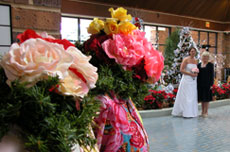Human Flower Project
Saturday, March 30, 2013
Unless Change Is a Language
Plants and flowers have their colors
and shapes. They sway in the wind yet
their roots support them
and they live to grow.
If they wither
it is not said
unless change is language.
—David Ignatow
Wednesday, July 11, 2012
Mandorla: Intersecting Worlds
With a tragedy in Russia, mourners and their florists turn to an old figure of Eastern Orthodox iconography, shaped like a seed.

A Russian Orthodox priest blesses graves outside Krymsk.
Overnight floods in Krymsk, a southern Russia city east of the Black Sea, killed at least 172 people early Sunday morning. There had been no warning, even though authorities later admitted having known by 10 p.m. Saturday that heavy rains threatened to inundate the town.
Some of the survivors (more than 25,000 lost their homes and belongings) say they believe that along with flooded natural waterways, more water was actually released from a reservoir above the city, “a theory rebutted by scientists from Russia’s environmental monitoring service, who said Friday’s rains swelled nearby rivers with the equivalent of six months’ average precipitation.”
Recriminations have been mounting. And so have floral tributes to the dead. Thanks to Craig Cramer of Ellis Hollow for alerting us to these striking images taken in a makeshift graveyard outside Krymsk.
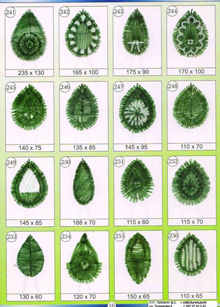 A Ukrainian florist advertises various designs for wreaths, most of them variations on the tear-drop form of the mandorla.
A Ukrainian florist advertises various designs for wreaths, most of them variations on the tear-drop form of the mandorla.
How different these sympathy arrangements are from the circular wreaths and sprays we’re accustomed to. All morning we’ve been searching for clues as to their distinctive shape. Egg? Seed? Womb? Teardrop?
After browsing through Russian and Ukrainian florists websites, we’re still not certain why this form of tribute is such a consistent floral presence at funerals in the region. We’ve read that even-numbered flowers are preferred (even required) at times of mourning and that yellow blooms are unwelcome at happy or sad occasions alike.
Having read up on Russian funeral customs and dipped into church symbolism, we’ve come to think that the massive oval-shaped arrangements follow an iconic shape in Eastern Orthodoxy—the mandorla.
This encapsulating form recurs in Christian imagery, a kind of radiant bubble that surrounds divine figures when they appear to humankind.
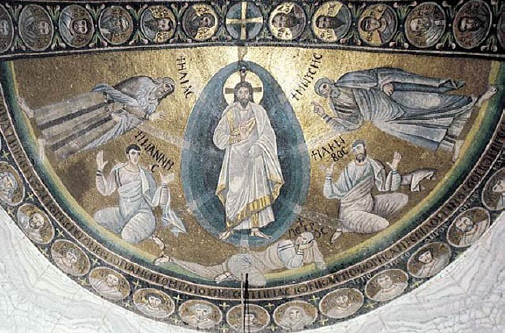
One of the earliest such images is this Apse mosaic of the Transfiguration, St. Catherine’s Monastery, Mount Sinai, c. 550-565
“The term refers to the almond like shape: “mandorla” means almond nut in Italian. In icons of the Eastern Orthodox Church, the mandorla is used to depict sacred moments which transcend time and space, such as the Resurrection, Transfiguration, and the Dormition of the Theotokos.”
In Pythagorean symbolism and pre-Christian art, the mandorla shape was conceived as two intersecting circles, alluding again to a kind of “eclipse,” when two different dimensions coalesce; momentarily, there’s a keyhole that makes it possible to see a more essential reality than we know in everyday life.
These pendulous wreaths, often fashioned with concentric rings of flower-color, remind us of the luminous cloud around our Lady of Guadalupe, a form that both protects and projects the power residing inside.
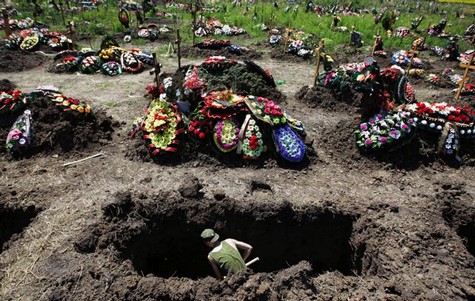
A soldier digs a grave outside Krymsk, Russia. More than 170 residents of the town died in early morning floods Sunday July 8.
Photo: Sergey Ponomarev, for AP
The intersection of opposites certainly comes through in Sergey Ponomarev’s astonishing photo from the Krymsk cemetery. A pale young man (or is it a girl?) shovels inside a grave, a black block surrounded with mud, while on the ground above scores of the bright egg-shaped arrangements lie across fresh gravemounds; all the way to the horizon, they shine back at the sky.
Thursday, July 05, 2012
Royalish Flower Seed
Seed from some of the plants grown at Buckingham Palace are now on sale, but will their royal connections get them across international borders?
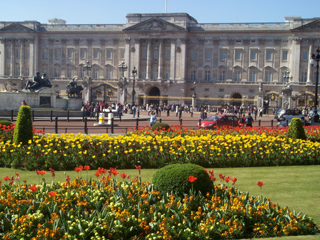
The gardens at Buckingham Palace
You may not be royalty, but you too can grow poppies (even we have managed that). Nobody curtsey for you recently? Stand tall, and grow the same upright ginger as blooms at Buckingham Palace.
The BBC reports that 11 plant varieties from among the more than 350 flowers that grow there can be yours.
During the Hampton Court Flower Show, running until Sunday, the seed will be for sale at the Plant Heritage Seed Shop, for a minimum £1 donation to “the charity.” (which we take to mean Plant Heritage, not the British monarchy, which seems to be solvent).
Sunday, July 01, 2012
A Gentle Correction
About 10 days ago, we cited a New York Times article explaining why Burma’s human rights leader wears flowers in her hair. She kindly corrected us both, us all.

Aung San Suu Kyi pinned a supporter’s flowers in her hair on the day she was released from house arrest.
While visiting France in late June, Burmese human rights leader Aung San Suu Kyi, who recently had accepted her Nobel Peace Prize, remarked on the customary flowers in her hair. The New York Times had reported that she wore them in memory of her late father, who would put flowers in her hair. HFP seized on this information and passed it along.
But Aung San Suu Kyi corrected that notion recently while visiting France.
“You see, I was only two when my father died,” she said. “And at that time, I had no hair! In Burma we believed if you shaved children’s hair, it grows back thick and long. And my hair was always shaved, so it’s only a myth that he placed flowers there… but I’m very touched people think he did.
“The reason why I wear flowers in my hair is actually because my mother used to do so. This was very much a Burmese tradition. But these days Burmese girls have started cutting their hair short so they no longer wear flowers. And on top of it, they don’t know how or have great difficulty doing it. Even my personal assistant—who has short hair—doesn’t know how to help me.”
